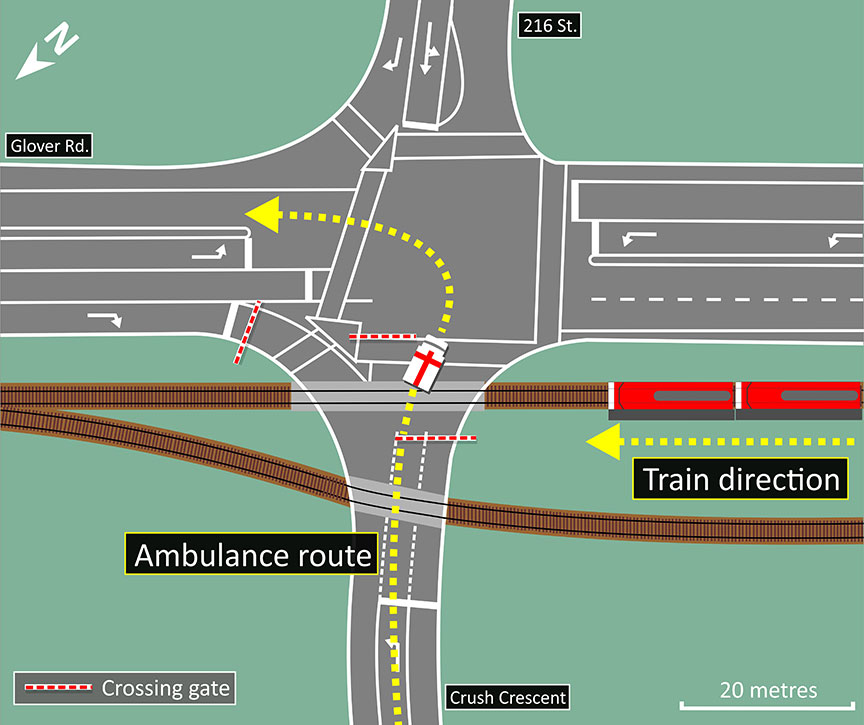Grade crossing collision
Canadian National Railway Company
Langley, British Columbia
The occurrence
On , at approximately 1120 Pacific Daylight Time, Canadian National Railway train Q10251-11, travelling northward on the Canadian Pacific Railway Page Subdivision, collided with an ambulance at the Crush Crescent–Glover Road crossing (Mile 18.81) in Langley, British Columbia. The paramedic in the patient compartment and the patient suffered injuries and were airlifted to hospital. The driver was transported to hospital, treated, and released. The patient later died of injuries sustained in the accident
Safety communications
Safety advisories
Rail safety advisory letter 06/17: Jurisdictional responsibility for roadway markings at Crush Crescent – Glover Road crossing in Langley, BC
Rail safety advisory letter 07/16: Crossing Safety at Crush Crescent / Glover Road in Langley, BC
Media materials
News releases
Complexity of the railway crossing and driver distraction led to 2015 fatal railway crossing accident in Langley, British Columbia
Read the news release
Update on TSB investigation into 11 September 2015 fatal railway crossing collision in Langley, British Columbia
Read the news release
Speeches
News conference for the release of Railway Investigation Report R15V0191: Opening remarks
Peter Hickli
Investigator-in-Charge, Transportation Safety Board of Canada
Sarah Harris
Human Factors Investigator, Transportation Safety Board of Canada
Deployment notice
TSB investigating crossing accident in Langley, British Columbia
The Transportation Safety Board of Canada (TSB) is conducting an investigation into the 11 September 2015 crossing accident involving a Canadian National train and an ambulance in Langley, British Columbia.
Investigation information
Download high-resolution photos from the TSB Flickr page.
Class of investigation
This is a class 3 investigation. These investigations analyze a small number of safety issues, and may result in recommendations. Class 3 investigations are generally completed within 450 days. For more information, see the Policy on Occurrence Classification.
TSB investigation process
There are 3 phases to a TSB investigation
- Field phase: a team of investigators examines the occurrence site and wreckage, interviews witnesses and collects pertinent information.
- Examination and analysis phase: the TSB reviews pertinent records, tests components of the wreckage in the lab, determines the sequence of events and identifies safety deficiencies. When safety deficiencies are suspected or confirmed, the TSB advises the appropriate authority without waiting until publication of the final report.
- Report phase: a confidential draft report is approved by the Board and sent to persons and corporations who are directly concerned by the report. They then have the opportunity to dispute or correct information they believe to be incorrect. The Board considers all representations before approving the final report, which is subsequently released to the public.
For more information, see our Investigation process page.
The TSB is an independent agency that investigates air, marine, pipeline, and rail transportation occurrences. Its sole aim is the advancement of transportation safety. It is not the function of the Board to assign fault or determine civil or criminal liability.
